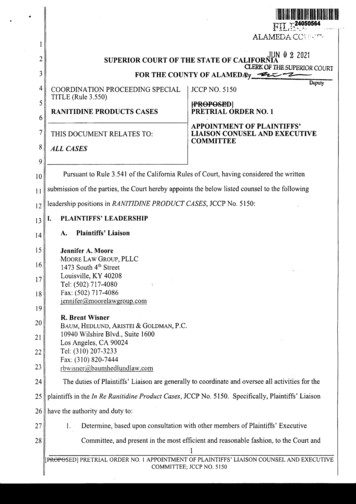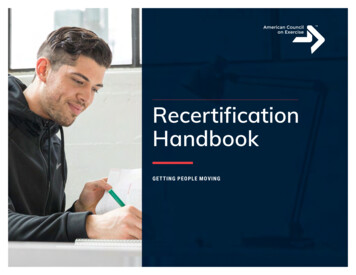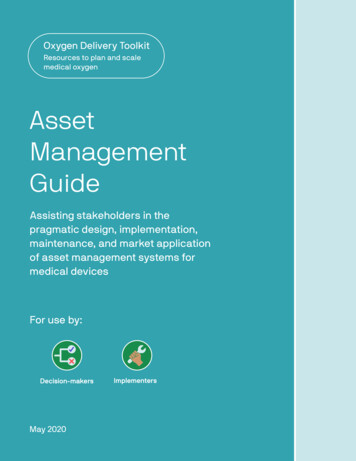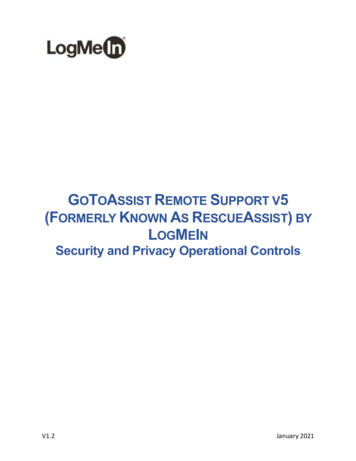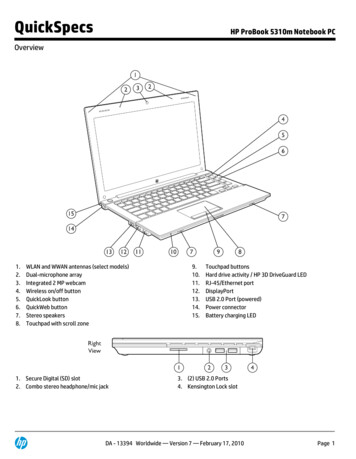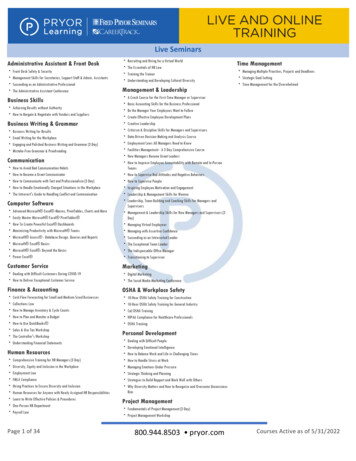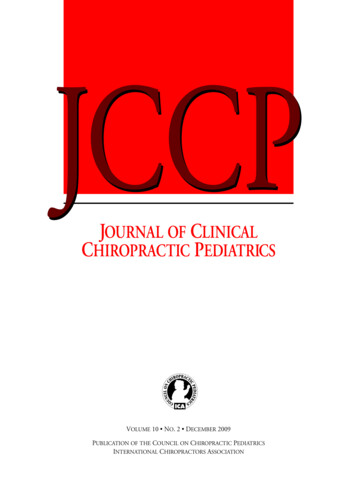
Transcription
JCCPJOURNAL OF CLINICALCHIROPRACTIC PEDIATRICSVolume 10 No. 2 December 2009PublicatioN of the couNcil oN chiroPractic PeDiatricsiNterNatioNal chiroPractors associatioN
JCCPJOURNALOF CLINICALCHIROPRACTICPEDIATRICSISSUE EDITORCheryl Hawk, D.C., Ph.D.EDITORIAL REVIEW BOARDPeter N. Fysh, D.C., F.I.C.C.P.Professor EmeritusPalmer College of Chiropractic-WestSan Jose, CaliforniaMaxine McMullen, D.C., F.I.C.C.P.Professor of Pediatrics (Rtd)Port Orange, FloridaChristine Hyman, D.C., D.I.C.C.P. (F)Private PracticeDallas, TexasMolly Rangnath, M.A.International Chiropractors AssociationArlington, VirginiaLora Tanis, D.C., D.I.C.C.P.Hewitt, New JerseyRosemary Valero, D.C., D.I.C.C.P.Palmer College of Chiropractic – FloridaPort Orange, FloridaSharon Vallone, D.C., F.I.C.C.P.Tolland, ConnecticutThe Journal of Clinical Chiropractic Pediatrics (JCCP)is the official peer-reviewed journal of the Council onChiropractic Pediatrics, 1110 N. Glebe Road, Suite 650,Arlington, Virginia, 22201, U.S.A. Printed and mailedin Virginia, U.S.A.Copyright by the Council on Chiropractic Pediatrics.All rights reserved. Reproduction or translation of anypart of this work beyond that permitted by Section 107or 108 of the United States Copyright Law withoutpermission of the copyright owner is unlawful. Printedin the United States.Editorial Correspondence: Editorial correspondenceshould be sent to the Editor, JCCP, ICA Council onChiropractic Pediatrics, 1110 N. Glebe Road, Suite650, Arlington, Virginia 22201, U.S.A. Email: pediatricscouncil@chiropractic.org
TABLE OF CONTENTSJCCPJOURNAL OF CLINICALCHIROPRACTIC PEDIATRICSVOLUME 10, NUMBER 2DECEMBER, 2009Editorial645Cheryl Hawk, D.C., Ph.D.First Do No Harm – Chiropractic Care and the Newborn647Sharon Vallone, D.C., F.I.C.C.P, Peter N. Fysh, D.C., F.I.C.C.P., and Lora Tanis, D.C., D.I.C.C.P.Safety of Chiropractic Manual Therapy for Children: How Are We Doing?655Joyce E. Miller, D.C., D.A.B.C.O.The Role of Chiropractic in Identifying and Reporting Intentional Injuries in Children661Mark T. Pfefer, R.N., M.S., D.C., Stephan R. Cooper, D.C. and Samuel YoderInjuries in the Pediatric Patient: Review of Key Acquired and Developmental Conditions665Beverly Hager, D.C., D.A.C.B.R. and Kim Mullen, D.C.Counseling on Unintentional Injury Prevention:How Chiropractors Can Help Keep Children Safe671Cheryl Hawk, D.C., Ph.D.Chiropractic Treatment of Children: Reimbursement Issues676Ronald J. Farabaugh, D.C.Grand Rounds Case #1: Infantile Colic681Presenter: Sharon Vallone, D.C., F.I.C.C.P.Discussants: Cliff O’Callahan, M.D., Ph.D., F.A.A.P. ; Jennifer Tow, I.B.C.L.C.; Miela Gruber Cooley, N.D.and Joyce E. Miller, D.C., D.A.B.C.O.Grand Rounds Case #2: Teen with Back Pain Complicated by Obesity687Presenter: Robert Leach, D.C., M.S., F.I.C.C., C.H. E.S.Discussants: Will Evans, D.C., Ph.D., C.H.E.S.; Ronald D. Williams Jr., Ph.D., C.H.E.S.and Dawn Privett, R.D.L.D.ABSTRACTS692PUBLISHING OFFICES:ICA COUNCIL ON CHIROPRACTIC PEDIATRICS1110 N. Glebe Road, Suite 650Arlington, Virginia 22201 U.S.A.Phone: 703-528-5000Fax: 703-351-7893
Chiropractic Treatment of Children:Reimbursement IssuesRONALD J. FARABAUGH, D.C.ABSTRACTIn the United States, some incidents have occurred in which insurance carriers have used discriminatory policies to deny chiropractic care for children. This article explores the issue of discriminatory insurance reimbursement related to chiropractic care ofchildren and provides strategies to address these issues when they occur.Keywords: chiropractic: pediatric spinal manipulation, chiropractic cost effectiveness, chiropractic research.Issues in insurance coverageof chiropractic care for childrenImagine successfully treating a 10 year old child forlow back pain, torticollis, asthma, or otitis media, onlyto be denied reimbursement by the insurance companyciting “treatment unproven and investigational.” In 2007one major national carrier released a policy which wouldhave denied treatment to children and adolescents citingtreatment as “unproven.”1 That policy was suspended butother discriminatory benefit policies still exist in scatteredpayor systems around the United States. When faced withimproper denials, what should you do? How would yourespond? This article explores the issue of discriminatoryinsurance reimbursement related to chiropractic care ofchildren and provides strategies to address these issueswhen they occur.Most large payors avoid obvious discriminatory policies by stating that reimbursement does not depend uponthe age of the patient, but upon the ICD9 and CPT codessubmitted. Therefore while many carriers do provide reimbursement for common childhood conditions managed bychiropractic physicians, others may take a more back-doorapproach for denials. Some carriers may implement internaledits which match certain diagnostic codes to employeridentification numbers which identify the provider type,and when a chiropractic physician is identified, payment isdenied. Chiropractors should report all improper denials totheir national association. When a policy is identified thataffects the treatment of children, our profession needs toact, as it did in 2007 to obtain the suspension of the policymentioned above.Ronald J. Farabaugh, D.C.Clinic Director, Farabaugh Chiropractic Clinic, Columbus, OhioEmail: CHIRONF@aol.com676For some outside of the chiropractic profession, treatment of children seems illogical, even dangerous. Why?Similar to the general population, most medical physiciansand insurance administrators are unfamiliar with the literature related to the chiropractic management of childhood disorders. Additionally, most have never witnessed aspinal manipulation and/or do not consider the reality thatchiropractic is a profession, not a procedure. All too oftenmedically oriented providers and administrators reducethe chiropractic profession, for reimbursement purposes,to the single procedure of a chiropractic adjustment, codedas spinal manipulation(s) (ex., 98940-CMT 1-2 areas, or98941, CMT 3-4 areas). Based upon licensure alone manyinsurers inappropriately deny reimbursement to chiropractic physicians for other medically necessary services such asE/M codes, nutritional analysis, advice on fitness, wellness,and prevention, which are all services normally reimbursedif provided by medical physicians.The evidence base for chiropractic care forchildren with mon-musculoskeletal conditionsNoted attorney and author David Chapman-Smithpoints out that many critics suggest that chiropractic carefor children is not appropriate since it is not yet supportedby randomized controlled trials (RCTs). However, this isnot really an adequate reason for denial of care, since mostmedical and other healthcare interventions, includingphysical therapy, are also not supported by RCTs.2Chiropractic physicians could avoid reimbursementissues related to the treatment of children by first becomingfamiliar with the supportive literature. One comprehensive review regarding non-musculoskeletal conditions waspublished in 2007 and suggested that several conditionshave good evidence supporting chiropractic management(not limited to spinal manipulation, but the entire clinicalJOURNAL OF CLINICAL CHIROPRACTIC PEDIATRICSVolume 10, No. 2, December 2009
Ronald J. Farabaugh, D.C.encounter). Dr. Hawk and her team found that evidencewas adequate to support the benefit of chiropractic carefor the treatment of: asthma, cervicogenic vertigo, andinfantile colic. Evidence was promising for potential benefitof manual procedures for children with otitis media. Theauthors also found that adverse effects of spinal manipulation for all ages and conditions were rare, transient, andnot severe.3beyond any reasonable degree of doubt that chiropractorshave a more thorough training in spinal mechanics andspinal manual therapy than any other health professional.It would therefore be astonishing to contemplate that achiropractor, in those areas of expertise, should be subjectto the directions of a medical practitioner who is largelyignorant of those matters simply because he has had notraining in them.”10The evidence base for chiropractic carefor children with musculoskeletal conditionsHow safe is Chiropractic?Chiropractic physicians are trained to address the broadspectrum of musculoskeletal conditions/injuries. We oftentreat shoulder, elbow, wrist, hip, knee and ankle pain, inaddition to other musculoskeletal conditions. In particularthough, spine pain in children has become a huge problemand tremendous financial burden on society. A review ofthe literature reveals a higher prevalence for thoracic spinepain (TSP) in child and adolescent populations, and particularly for females. TSP was significantly associated with:concurrent musculoskeletal pain; growth and physical;lifestyle and social; backpack; postural; psychological; andenvironmental factors.4Studies conducted in the United States and throughoutthe world consistently demonstrate the high incidence oflow back pain in children. One study stated that LBP inchildhood and adolescence is also as common a problem asthat for adults. Another found that about every fifth childin the school-age population reports low back pain.5-7 Giventhe prevalence of spine pain in children, and the limitedtraining of medical providers regarding musculoskeletaldisorders, it only seems logical that well-trained chiropracticphysicians who specialize in the diagnosis and treatment ofspine disorders function as primary care providers for thispatient population.Physician education related to musculoskeletal careA significant amount of education and training inchiropractic college is focused on diagnosis and treatmentof musculoskeletal disorders. In contrast, the musculoskeletal training in medical education has recently has beendescribed as “woefully inadequate” in preparing medicaldoctors for the diagnosis and treatment of musculoskeletal conditions, and these deficits stem from the lackof educational and clinical training provided to medicalstudents in musculoskeletal diagnosis and treatment.8,9 In1979 the Royal Commission of Inquiry on Chiropractic inNew Zealand addressed the issue of medical incompetencefor back pain. “The Commission has found it establishedVolume 10, No. 2, December 2009A 2008 study of 781 case files of children youngerthan 3 years receiving chiropractic care found no seriousadverse events.11 A 2007 systematic review by Vohra etal found that although rare serious adverse events hadbeen reported among children receiving chiropractic care,causation could not be inferred and that further study isneeded.12 The authors of a 2009 study reported in Spineconducted an electronic search in two databases: Pubmedand the Cochrane Library for the years 1966 to 2007.Their findings: “There is no robust data concerning theincidence or prevalence of adverse reactions after chiropractic.”13In 2007, the Council on Chiropractic Guidelines andPractice Parameters (CCGPP) reviewed the issue regarding attempts by insurance companies to deny paymentfor treatment of children. In their opinion policies whichlimit access to chiropractic physicians may result in thepotential harm to children by denying medically necessaryand evidence-based chiropractic care. The following issues,which were addressed in a joint letter to a major insurancecarrier by the Council on Chiropractic Guidelines and Practice Parameters (CCGPP), the Congress of ChiropracticState Associations (COCSA), the American ChiropracticAssociation (ACA), the International Chiropractors Association (ICA), the Foundation for Chiropractic Educationand Research (FCER), and the Association of ChiropracticColleges (ACC) should be considered when issues relatedto reimbursement of chiropractic care for children arise.Issue #1: Scope of practiceMany insurers who develop policies regarding “chiropractic services” presumably and mistakenly equate thelicensure of the chiropractic profession with the single modality/procedure of spinal manipulation (ex., 98940-CMT1-2 areas, 98941-CMT 3-4 areas). As is well-established,chiropractors are primary care/portal of entry physiciansrecognized by statute at both federal and state levels, e.g.Medicare, Medicaid, Department of Defense and Veterans Administration programs. The treatment of specialJOURNAL OF CLINICAL CHIROPRACTIC PEDIATRICS677
Chiropractic Treatment of Children: Reimbursement Issuespatient populations, children and adolescents, and specificconditions like headaches have been established for manyyears to be well within the scope of a chiropractic practice.Treatment includes not only spinal manipulation, but alsoactive and passive therapeutic modalities, evaluation andmanagement services, instruction on lifestyle modifications, diet and exercise, posture and nutritional advice andother facets of chiropractic practice. Chiropractic is notlimited to just spinal manipulation and it is often unclearwhether other aspects of a chiropractic clinical encounterare reimbursable.eral health, more limited physical functioning, and morebodily pain. There is widespread concern that heavy backpacks carried by adolescents contribute to the developmentof back pain.15Issue #2: Discriminatory policy/standardsNumerous recognized and respected guidelines support the use of spinal manipulation, along with othertherapies, in the treatment of back pain. Recently, thewidely-respected journal, Annals of Internal Medicinestated: “Recommendation 7: For patients who do notimprove with self-care options, clinicians should considerthe addition of nonpharmacologic therapy with provenbenefits — for acute low back pain, spinal manipulation[emphasis added]; for chronic or subacute low back pain,intensive interdisciplinary rehabilitation, exercise therapy,acupuncture, massage therapy, spinal manipulation[emphasis added], yoga, cognitive-behavioral therapy, orprogressive relaxation.16, 17Many insurers do not apply standards concerningresearch in equal fashion across the spectrum of healthcareprofessions. In fact, if every licensed profession were held tothe same unrealistic standard being imposed by some payerson the chiropractic profession, many fewer treatments anddrugs would be reimbursable by carriers.Issue #3: ResearchResearch related to the adult population is plentiful.Literature related specifically to children is less voluminous;however, is it truly necessary? What evidence exists indicating that the spines of children and adolescents respond anydifferently to spinal manipulation and numerous other passive and active interventions used not only by chiropracticphysicians, but medical and osteopathic physicians andphysical therapists? What evidence exists that would suggest that children and adolescents are somehow immuneto spine dysfunction, injury or pain? To deny coveragefor a special population of patients based upon the lackof research is analogous to denying payment for spinalmanipulation for patients living in West Virginia since norandomized trials exist for that population of patient. Inour opinion, restrictions implemented based upon lack ofresearch represents flawed logic in its application of researchin a clinical setting. Does any literature exist suggestingthat the spines of children and adolescents respond anydifferently to passive and active modalities and treatmentcompared to adult populations for which spinal manipulation has proven value?For example, the literature clearly shows that childrensuffer significant back pain.14 In fact, in a study of 1,126children, the prevalence of nonspecific back pain increaseddramatically during adolescence from less than 10% inthe pre-teenage years up to 50% in 15- to 16-year-olds.Of 1,122 backpack users, 74.4% were classified as having back pain, accompanied by significantly poorer gen-678Other contributing factors to the near epidemic ofback pain in adolescents are: sedentary lifestyle, obesity,de-conditioning, excessive sitting, poor diet, etc. These issues not only can all be addressed, but are being routinelyaddressed with successful therapeutic outcomes, in thenormal visit to a chiropractic physician.Issue # 4: Clinical skills, financial impact,and patient safetyGiven the reality of back pain in children and adolescents, why would an insurer restrict access and benefits tothe profession best suited to evaluate and treat such childhood conditions? Chiropractic physicians clearly possessmore education and clinical skills in the area of musculoskeletal diagnosis and treatment compared to generalallopaths and physical therapists. If restrictive policies arepermitted, young patients will have nowhere to turn exceptto general medicine. Will that shift result in dollars saved?The answer is no. A limited or complete loss of chiropractic benefits will result in a shift and increased payment fortraditional care with its inherent higher costs for treatment,diagnostics and risks associated with prescriptions and invasive procedures. Given the fact that our society, especiallythe young, is already overmedicated, does that policy makegood fiscal or epidemiological sense? We, as a profession,are justifiably concerned that policies that restrict accessto chiropractic physicians will force unnecessary drugs onchildren who suffer back pain and other conditions commonly treated by chiropractic physicians. The side effectsof those drugs can easily be avoided by the use of moreconservative chiropractic care.JOURNAL OF CLINICAL CHIROPRACTIC PEDIATRICSVolume 10, No. 2, December 2009
Ronald J. Farabaugh, D.C.Issue #5: Proper use of guidelinesand best practice strategy in clinical practiceRestrictive policies often fail to consider that evidence/research is only one facet of a best practice strategy inclinical practice. Other equally important elements include clinical decision-making/experience, patient values,documentation, process of care, response to care, and riskstratification. Over reliance on literature is impractical in aclinical setting where all patients are unique. In the absenceof a definitive body of literature, individual clinicians mustrely on their clinical judgment to formulate reasonableparameters of care.18 Recently, a formal consensus processon such parameters was conducted by a multidisciplinarygroup of experienced clinicians and researchers, fundedby the Foundation for Chiropractic Education and Research.19dren can be one of the most rewarding experiences for achiropractic physician. At the same time, inappropriatedenials often cause undue stress, dampening the enthusiasmgenerated by healthier children and their grateful parents.Our collective efforts in this ongoing fight for a levelplaying field must include education in every venue possible, including decision and policy-makers in the insurance industry. Doctors of chiropractic are truly gifted atspreading the good news of favorable research amongourselves. The time has come to inform the rest of societyof the cost effectiveness, safety, and efficacy of chiropractic healthcare. The educational process begins with eachindividual DC.References1 United Healthcare Network Bulletin 2007;21(September).2. Chapman-Smith D. The Chiropractic Report 2009;23(4).Issue #6: Civil rights of childrenA major concern is the possible violation of civil rightsagainst this special population, children. Discriminationbased upon age is not acceptable in any venue. Given thelack of reason, science, logic, clinical applicability, and theapparent double standards imposed on chiropractic versusmedical licensees, restrictive policies should be immediatelywithdrawn by the insurance industry. Forcing children intomore invasive medical procedures, including medications,by denying coverage for more conservative treatment shouldnot be acceptable to anyone.In summary, if a chiropractor encounters discriminatory restrictive policies that prevent necessary treatment ofchildren, he or she should alert the national association. Inorder to avoid, or at least diminish the potential for, denialsfollow these simple rules:1) Become familiar with the literature regarding themost common conditions appropriately treated bychiropractic physicians.2) Use the most appropriate diagnosis, including themusculoskeletal diagnosis, if spinal manipulation is theprimary treatment utilized. It should be rememberedthat the chiropractor is often not treating a condition,such as colic, directly, but rather the spinal dysfunctioncausing the symptoms.3) Avoid billing for diagnoses outside of those conditionssupported by the literature.4) Be sure to provide the treatment and modalities consistent with the injury/condition.Successfully treating suffering babies and young chil-Volume 10, No. 2, December 20093. Hawk C, Khorsan R, Lisi AJ, Ferrance RJ, Evans MW. Chiropractic care for nonmusculoskeletal conditions: a systematic reviewwith implications for whole systems research. J Altern ComplementMed 2007;13(5):491-512.4. Briggs AM, Smith AJ, Straker LM, Bragge P. Thoracic spine painin the general population: prevalence, incidence and associatedfactors in children, adolescents and adults. A systematic review.BMC Musculoskelet Disord 2009;10:77.5. Ebrall PS. The epidemiology of male adolescent low back pain ina north suburban population of Melbourne, Australia. J Manipulative Physiol Ther 1994;17(7):447-53.6. Bockowski L, Sobaniec W, Kulak W, Smigielska-Kuzia J, Sendrowski K, Roszkowska M. Low back pain in school-age children:risk factors, clinical features and diagnostic managment. Adv MedSci 2007;52 Suppl 1:221-3.7. Sato T, Ito T, Hirano T, et al. Low back pain in childhood andadolescence: a cross-sectional study in Niigata City. Eur Spine J2008;17(11):1441-7.8. Jandial S, Myers A, Wise E, Foster HE. Doctors likely to encounter children with musculoskeletal complaints have low confidencein their clinical skills. J Pediatr 2009;154(2):267-71.9. Joy E, Hala SV. Musculoskeletal curricula in medical education:filling in the missing pieces Physician Sportsmed 2004;32:42-5.10. McAndrews G. Spokes of chiropractic progress. Washington DC:American Chiropractic Association; 2003.11. Miller J, Benfield K. Adverse effects of spinal manipulativetherapy in children younger than 3 years: a retrospective studyin a chiropractic teaching clinic. J Manipulative Physio Ther2008;31(6):419-23.12. Vohra S, Johnston BC, Cramer K, Humphreys K. Adverse eventsassociated with pediatric spinal manipulation: a systematic review.Pediatrics 2007;119(1):e275-83.13. Gouveia LO, Castanho P, Ferreira JJ. Safety of chiropractic interventions: a systematic review. Spine (Phila Pa 1976)2009;34(11):E405-13.JOURNAL OF CLINICAL CHIROPRACTIC PEDIATRICS679
Chiropractic Treatment of Children: Reimbursement Issues14. Hestbaek L, Leboeuf-Yde C, Kyvik KO, Manniche C. Thecourse of low back pain from adolescence to adulthood: eightyear follow-up of 9600 twins. Spine (Phila Pa 1976)2006;31(4):468-72.17. Chou R, Qaseem A, Snow V, et al. Diagnosis and treatment oflow back pain: a joint clinical practice guideline from the American College of Physicians and the American Pain Society. AnnIntern Med 2007;147(7):478-91.15. Sheir-Neiss GI, Kruse RW, Rahman T, Jacobson LP, Pelli JA. Theassociation of backpack use and back pain in adolescents. Spine(Phila Pa 1976) 2003;28(9):922-30.18. Fallon J. The child patient, a matrix for chiropractic care. J ClinChiropr Pediatr 2005;6(3 Suppl):1-14.16. Summaries for patients. Diagnosis and treatment of low backpain: recommendations from the American College of Physicians/American Pain Society. Ann Intern Med 2007;147(7):I45.19. Hawk C, Schneider M, Ferrance R, Hewitt E, Van Loon M,Tanis L. Best practices recommendations for chiropractic care forchildren: results of a consensus process. J Manipulative PhysiolTher 2009;32:639-47. 680JOURNAL OF CLINICAL CHIROPRACTIC PEDIATRICSVolume 10, No. 2, December 2009
JourNal of cliNical chiroPractic PeDiatrics
chiropractic physicians, others may take a more back-door approach for denials. Some carriers may implement internal edits which match certain diagnostic codes to employer identification numbers which identify the provider type, and when a chiropractic physician is identified, payment is denied. Chiropractors should report all improper denials to

